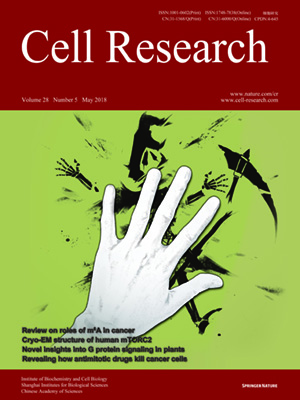
Volume 28, No 5, May 2018
ISSN: 1001-0602
EISSN: 1748-7838 2018
impact factor 17.848*
(Clarivate Analytics, 2019)
Volume 28 Issue 5, May 2018: 507-517
REVIEWS
RNA N6-methyladenosine modification in cancers: current status and perspectives
Xiaolan Deng 1,2,3, Rui Su 1,3, Hengyou Weng 1,3, Huilin Huang 1,3, Zejuan Li 4 and Jianjun Chen 1,3
1 Department of Systems Biology & the Gehr Family Center for Leukemia Research, The Beckman Research Institute of City of Hope, Monrovia, CA 91016, USA; 2School of Pharmacy, China Medical University, Shenyang 110122, China; 3Department of Cancer Biology, University of Cincinnati College of Medicine, Cincinnati, OH 45219, USA and 4Department of Human Genetics, University of Chicago, Chicago, IL 60637, USA
Correspondence: Correspondence: Xiaolan Deng (xideng@coh.org) or Jianjun Chen (jianchen@coh.org)
N6-methyladenosine (m6A), the most abundant internal modification in eukaryotic messenger RNAs (mRNAs), has been shown to play critical roles in various normal bioprocesses such as tissue development, stem cell self-renewal and differentiation, heat shock or DNA damage response, and maternal-to-zygotic transition. The m6A modification is deposited by the m6A methyltransferase complex (MTC; i.e., writer) composed of METTL3, METTL14 and WTAP, and probably also VIRMA and RBM15, and can be removed by m6A demethylases (i.e., erasers) such as FTO and ALKBH5. The fates of m6A-modified mRNAs rely on the functions of distinct proteins that recognize them (i.e., readers), which may affect the stability, splicing, and/or translation of target mRNAs. Given the functional importance of the m6A modification machinery in normal bioprocesses, it is not surprising that evidence is emerging that dysregulation of m6A modification and the associated proteins also contributes to the initiation, progression, and drug response of cancers. In this review, we focus on recent advances in the study of biological functions and the underlying molecular mechanisms of dysregulated m6A modification and the associated machinery in the pathogenesis and drug response of various types of cancers. In addition, we also discuss possible therapeutic interventions against the dysregulated m6A machinery to treat cancers.
doi:10.1038/s41422-018-0034-6
FULL TEXT | PDF
Browse 2036


